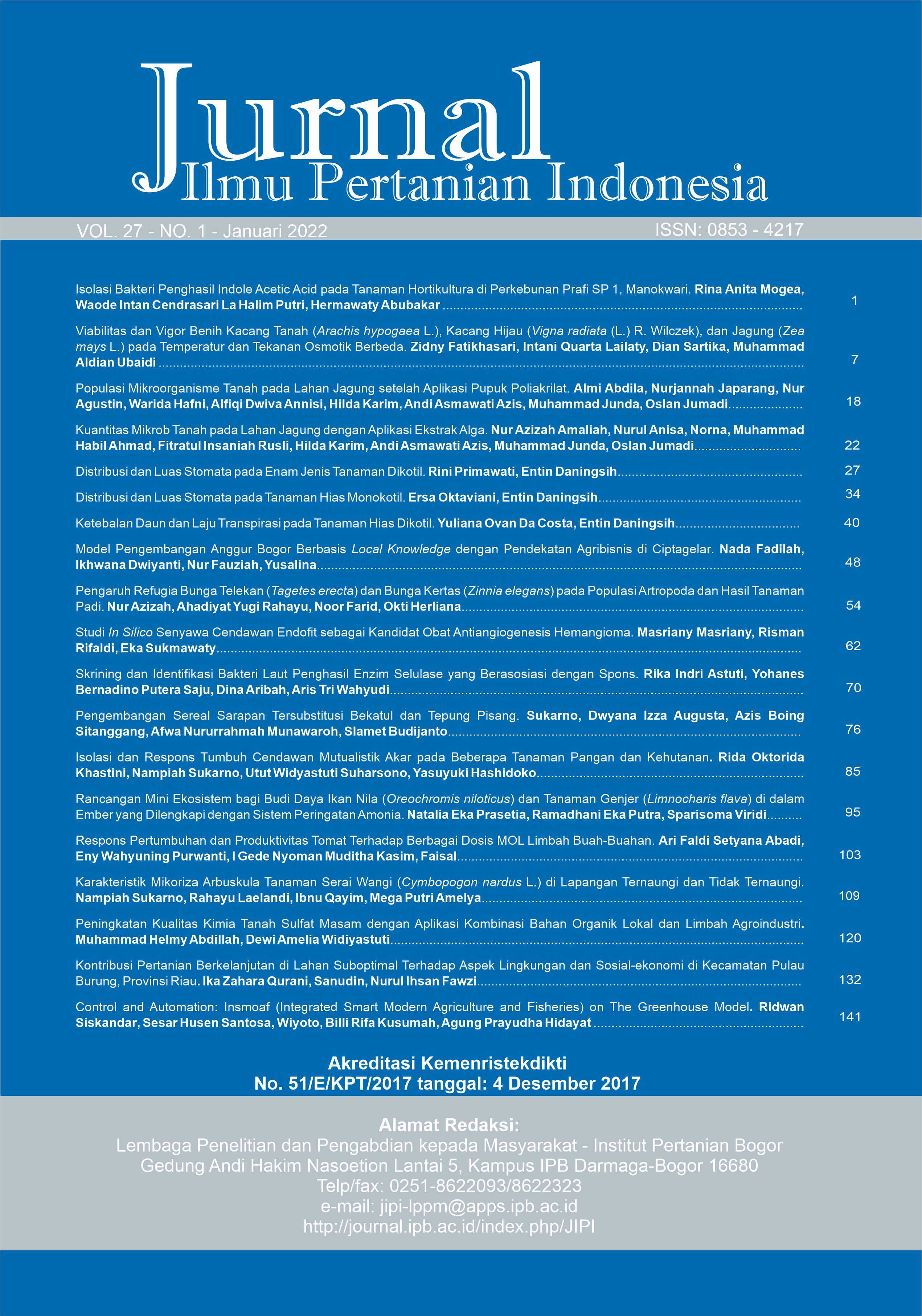Studi In Silico Senyawa Cendawan Endofit Sebagai Kandidat Obat Antiangiogenesis Hemangioma
Abstract
Increasing levels of angiogenic factors such as gamma interferon (Y-IF), tumor necrosis factor-beta (TNF-β), and transforming growth factor-beta (TGF-β) are thought to be the cause of the angiogenesis process in hemangiomas. Endophytic fungi are potential in searching for new drug sources due to their antimicrobial, antifungal, and anticancer compounds. This study aimed to determine the potential and interactions of endophytic fungi as candidates for vascular endothelial growth factor receptor-2 (VEGFR-2) angiogenesis hemangiomas and apply Lipinski's rule of five to differentiate drug-like and non-drug-like molecules and in-line toxicity using in silico test. The research method was molecular docking using several programs, namely Autodock Vina (PyRx), PyMol, and Discovery Studio 2019, and tethering five ligands from the endophytic fungus Trichoderma sp. and Aspergillus sp. with 2 VEGFR-2 target proteins (protein codes were 3VHE and 1Y6A). The best binding affinity of the ligands was tested by Lipinski's rule of five and toxicity test using Toxtree. The results showed that benzyl benzoate is potentially an antiangiogenesis inhibitor for VEGFR-2 protein based on its binding affinity value, which is close to the control ligand value of -8.7 kcal/mol (3VHE) and -7.4 kcal/mol (1Y6A). Therefore, benzyl benzoate, chloromycetin, and 1-hexyl-3-nitrobenzene compounds comply with Lipinski's rule of five. Based on the results of the toxicity test and the parameters of the Kroes TTC decision tree, benzyl benzoate and chloromycetin are categorized as safe compounds for consumption.
Keywords: angiogenesis, benzyl benzoate, endophytic fungi, molecular docking, VEGFR-2
Downloads
References
Agusta. 2015. 2009. Biologi dan kimia jamur Endofit. Bandung (ID): ITB Press.
Adriani. 2015. Prosising Seminar Nasional Mikrobiologi Kesehatan dan Lingungan. Aktiifitas Antibakterial fungi Endofit Coulerpa Racemosa Terhadap Bakteri Escherichia coli dan Staphylococcus aureus. Makassar, 29th Januari 2015.
Bhatia S, Schultz T, Roberts D, Shen J, Kromidas L, Marie AA. 2015. Comparison of cramer classification between toxtree, the OECD QSAR toolbox and expert judgment. Regulatory Toxicology and Pharmacology journal. 71(1): 52–62. https://doi.org/10.1016/j.yrtph.2014.11.005
Bhhatarai B, Wilson DM, Parks AK, Carney EW, Spencer PJ. 2016. Evaluation of TOPKAT, toxtree, and derek nexus in silico models for ocular irritation and development of a knowledge-based framework to improve the prediction of severe irritation. Chemical Research in Toxicology journal. 29(2): 413-418.
https://doi.org/10.1021/acs.chemrestox .5b00531
Boon LM, Ballieux F, Vikkula M. 2011. “Pathogenesis of vascular anomalies. Clin Plast Surg. 38(1): 7-19. https://doi.org/10.1016/j.cps.2010.08.012
Breugem CC, van Der Horst CM, Hennekam RC. 2001. Progress toward understanding vascular malformations. Plast Reconstr Surg. 107(6): 1509-23. https://doi.org/10.1097/00006534-200105 000-00033
Choy Y, Bin, Prausnitz MR. 2011. The rule of five for non-oral routes of drug delivery: ophthalmic, inhalation, and transdermal. Pharmaceutical Research. 28(5): 943–948. https://doi.org/ 10.1007/s11095-010-0292-6
Contrera JF. 2013. Validation of toxtree and SciQSAR in silico predictive software using a publicly available benchmark mutagenicity database and their applicability for the qualification of impurities in pharmaceuticals. Regulatory Toxicology and Pharmacology. 67(2): 285–293. https://doi.org/ 10.1016/j.yrtph.2013.08.008
Desen. 2008. Buku Ajar Onkologi Medik. edisi 2. Jakarta (ID): Balai penerbit FKUI.
Geldenhuys WJ, Gaasch KE, Watson M, Allen DD, Van der Schyf Cornelis J. 2006. Optimizing the use of open-source software applications in drug discovery. Drug Discov Today. 11(3-4): 127-132. https://doi.org/10.1016/S1359-6446(05)03692-5
Giavazzi R, Albini A, Bussolino F, DeBraud F, Presta M, Ziche M, Costa A. 2012. The biological basis for antiangiogenic therapy. European Journal of Cancer. 36(15): 1913-1918. https://doi.org/ 10.1016/S0959-8049(00)00276-8
Kumala S, Pratiwi AP. 2014. Efek antimikroba dari kapang endofit ranting tanaman biduri. Jurnal Farmasi Indonesia. 7(2): 111-120.
Mulliken JB, Glowacki J. 1982. Hemangioma and vascular malformations in infants and children: A classification based on endothelial characteristic. Plast Reconstr Surg. 69(3): 412-422. https://doi.org/10.1097/00006534-198203000-00002
Patlewicz G, Jeliazkova N, Safford RJ, Worth AP, Aleksiev B. 2008. An evaluation of the implementation of the Cramer classification scheme in the Toxtree software. SAR and QSAR in Environmental Research. 19(5–6): 495–524. https://doi.org/10.1080/10629360802083871
[Riskesdas] Riset Kesehatan Dasar. 2007. Badan Litbangkes, Depkes RI. Jakarta (ID).
Sudjatmiko G. 2010. Hemangioma. In: Petunjuk praktis ilmu bedah plastik rekonstruksi edisi 2. Jakarta (ID): Yayasan khazanah kebajikan.
Susanti S, Sukmawaty E, Masriany. 2021. Penambatan Molekuler Senyawa Cendawan Endofit Trichoderma sp. Sebagai Inhibitor Protein Lower Density Lipoprotein, Enzim Lanasterol 4A Demetilase dan Lipase yang Bertanggung Jawab dalam Dermatitis Seboroik. Jurnal Ilmiah Ibnu Sina. 6(1): 98-107. https://doi.org/10.36387/jiis. v6i1.636
Tambunan USF, Amri N, Parikesit AA. 2012. In silico design of cyclic peptide as influenza virus, a subtype H1N1 neuraminidase inhibitor. African Journal of Biotechnology. 11(52): 11474-11491. https://doi.org/10.5897/AJB11.4094
This journal is published under the terms of the Creative Commons Attribution-NonCommercial 4.0 International License. Authors who publish with this journal agree to the following terms: Authors retain copyright and grant the journal right of first publication with the work simultaneously licensed under a Creative Commons Attribution-NonCommercial 4.0 International License. Attribution — You must give appropriate credit, provide a link to the license, and indicate if changes were made. You may do so in any reasonable manner, but not in any way that suggests the licensor endorses you or your use. NonCommercial — You may not use the material for commercial purposes.























